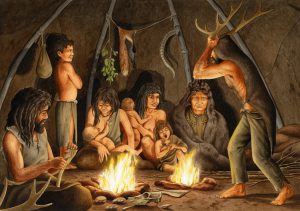
So…why do we keep telling stories? We’re professional, evolved people in the 21st century. Why are we communicating via a medium that a literal caveman would and could use?
Let’s go back a little bit. Say, a little bit as a little one million years back. That is the median date for mastering fire by our ancestors. There are people that think Homo Erectus did use fire 1.5 million years ago, but let’s stick to a conservative, cool one million years from now.
Now, while evolutionary speaking this can be sees as a blink of an eye, it is still a long, loooong time. From one million years ago, our ancestors were telling each other information across a fire. Now, this is of course so long ago that we cannot assign a date for the beginning of Storytelling. And since stories are mostly oral, we don’t have any document to back it up. But current research points that Homo Erectus already had language and stories. We know that Homo Sapiens already had the anatomy of modern man almost three hundred thousand years back, and most anthropologist believe that we have storytelling since. But the first storytelling that has left a document is found in the Lascaux caves. It has been drawn about eighteen thousands years ago.

This, of course, is not the accepted date that Storytelling began. Most anthropologist assign a date in the neighborhood of one million years ago. But still, let’s take this as a starting point. How many years has Excel been around? Twenty two years, as of 2017. And Powerpoint? As of this date, twenty years. So, for twenty two years we have been looking as spreadsheets, versus eighteen thousand at least for stories. Evolution is not on Excel’s corner.
We have evolved as Storytelling animals. We’re nothing more that Storytelling apes, that have created for some reason pants and donuts. Stories fulfill an important role, in our ape society: they allow us to share quickly information in a way that is more difficult to forget than pure data.
In this way, Stories are a highly effective vector for sharing information, more effective than Excel or Powerpoint. We’ve evolved this way, so…why should we not use stories? We’re working against our own nature if we don’t.
So..bottom line: you’re a storytelling ape, as I am.
Embrace it.








